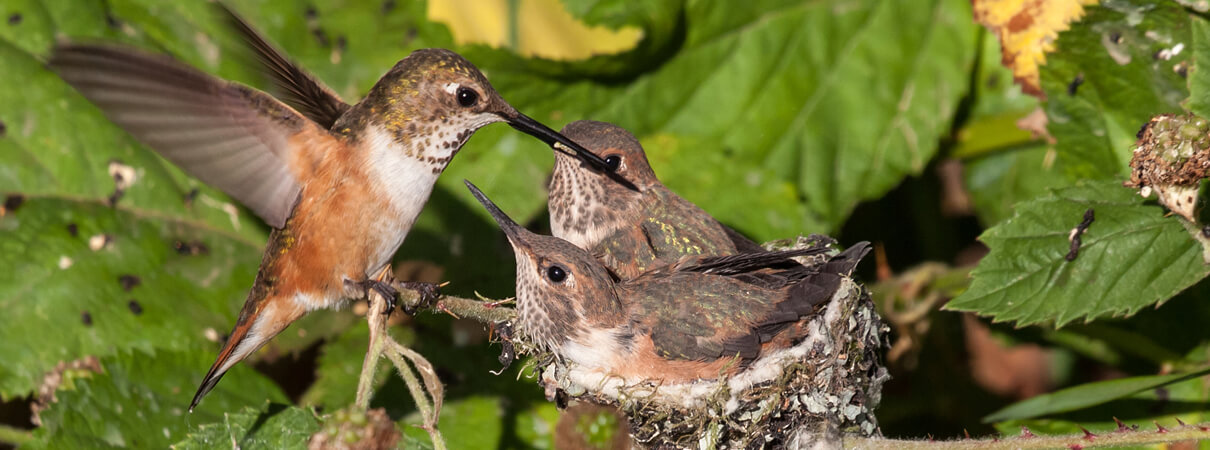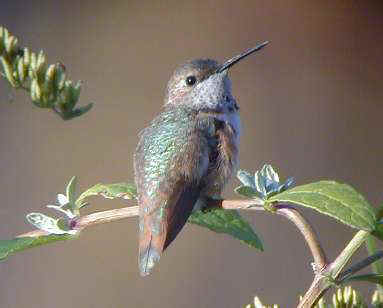

Report Winter Hummingbirds: If you leave a sugar-water feeder out during the fall and winter–and spot a hummingbird after November 1–the Hummer/Bird Study Group wants to know about it. Sources: “ The Hummingbirds of Winter” by Doreen Cubie, National Wildlife, December/January 2011, “ Tiny Trailblazers” by Scott Weidensaul, National Wildlife, December/January 2007, Cornell Lab of Ornithology’s All About Birds and National Wildlife Federation Field Guide to Birds of North America. Voice: Call a sharp, rich tchup, relatively low and resonant. “There’s no truth to the myth that keeping a feeder up after Labor Day will stop hummingbirds from migrating,” says Bob Sargent, who with his wife, Martha Sargent, runs the Clay, Alabama-based nonprofit Hummer/Bird Study Group. But watch out: Cornell Lab of Ornithology’s “ All About Birds,”-which shows this species wintering in Mexico-calls the rufous “the feistiest hummingbird in North America.” The birds “are relentless attackers at flowers and feeders, going after (if not always defeating) even the large hummingbirds of the Southwest, which can be double their weight.” These birds, in turn, head back to the breeding grounds in spring and spread their ‘faulty’ genes among the population.”īackyard Tips: Rufous hummingbirds readily visit sugar-water feeders and nectar-producing flowers in backyard gardens. In the past this might have been fatal, but those heading east now find a land of milk and honey, where ancient forests have been replaced by fields and homes (many with feeders) and where the climate is milder than it was just a generation ago. A licensed hummingbird bander himself, Weidensaul writes that “some birds-born with a genetic hiccup in their software-head the wrong way.

In another National Wildlife article, “ Tiny Trailblazers,” naturalist and writer Scott Weidensaul supports the idea that new migratory routes are evolving. “There’s an emerging consensus that ‘vagrant’ hummingbirds are some kind of genetic ‘scouts’ programmed to prospect for likely winter habitat,” adds Borchelt. For rufous, winter here isn’t that much different from early spring in the Rockies-they’re really hardy little birds.” “What I think is happening,” he says, “is that birds from the Canadian Rockies go east across the Plains on fall migration (instead of down the eastern side of the Sierra) and find patches of resources where they hang out for the season.

We’re getting some banding data to support that hummingbirds that are banded up your way are recaptured here a few months later.”īorchelt suspects his rufous may stick around longer. According to most bird guides, they are supposed to spend the nonbreeding season in Mexico.Īsked about Borchelt’s backyard visitor, Cubie says, “We think many of the rufous that overwinter in the Southeast move down through Pennsylvania and the mid-Atlantic during fall. Rufous hummingbirds, which breed as far north as south-central Alaska (farther north than any other hummingbird species), are considered western species. Over the past decade, Cubie’s colleague Fred Bassett has banded nearly 2,000 hummingbirds in the Southeast during winter almost half have been rufous hummingbirds, reports Bassett, who heads the Montgomery, Alabama-based Hummingbird Research, Inc. Author Doreen Cubie, a South Carolina-based freelance writer, is helping to investigate this phenomenon as a member of a coalition of some 30 federal- and state-licensed bird banders working in the region. “So far, every one of more than 100 visitors has seen the little beast.”Īccording to an article, “ The Hummingbirds of Winter,” in the current issue of National Wildlife, such out-of-range-and-season sightings of hummingbirds are becoming increasingly common, particularly in the Southeastern United States. Since then, “I have been overrun with the area’s birders,” says Borchelt. Schindler.Ībout a week before Thanksgiving, fellow science writer Rick Borchelt spotted a “ way out of season and way out of range” rufous hummingbird feasting at his backyard sugar-water feeder in College Park, Maryland.


 0 kommentar(er)
0 kommentar(er)
